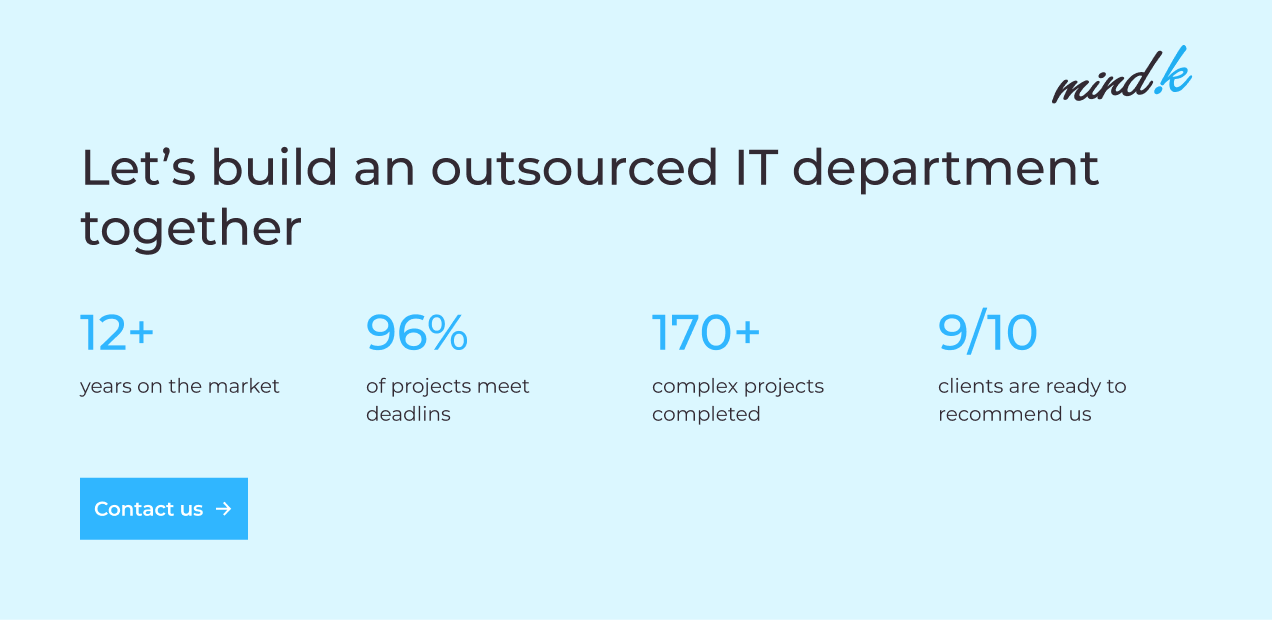Looking to build an outsourced IT department? Hiring an external provider to work on your software development project is a great way to fill your tech talent needs and get your project finished on time, without going over budget.
At MindK, we provide three types of IT outsourcing services: team augmentation, project outsourcing, and managed IT services. In this article, we’re going to clarify how outsourced IT departments work, and how you can build one, so you could have a better idea of how to get started with IT outsourcing.
But first of all, let’s figure out why outsourcing is needed in the first place
Reasons to outsource your IT needs
An outsourced IT department offers some great benefits, besides saving your budget on software development. Here is what you get by hiring a company like MindK to help you solve your software development challenges:
- Access to global tech talent
You can find qualified specialists with the needed tech and domain expertise to fill your software development needs. For example, at MindK, we specialize in Agile application development for web and mobile platforms. We also provide DevOps and test automation services. We’re built software projects in several industries including advertising, real estate, education, HR and recruitment, and finance.
- Cut costs
Entrepreneurs that outsource their IT projects to MindK significantly cut their overhead costs, use modern technologies that allow for increasing developer productivity and quality of delivery, and benefit from well-tuned project management that speeds up their products’ time to market.
- Delegate tasks
If you have an internal team working on your product, you can delegate some non-core activities to your external developers, and keep your in-house team focused on your core tasks.
- Faster market deployment
With more qualified resources for your software development project, you can reduce time-to-market and avoid employee burnout.
What services can be outsourced
Here are some tasks that you can outsource to MindK:
- Software development – building web and mobile applications.
- Product development – developing a product using Agile and Lean methodologies from prototyping to proof of concept to a minimum viable product (MVP) to full-fledged application.
- QA automation – implementing a set of reusable automation test scripts for end-to-end regression, performance, compatibility, and functionality testing.
- DevOps – automating deployment and transforming your IT operations from start to finish to increase your team’s efficiency and reduce errors.
- UI/UX design – creating user interfaces for your web and mobile applications following Design Thinking principles.
- Application support and maintenance – regular technical support for your application which includes bug fixing, troubleshooting, and new functionality development.
Read also: Agile software development consulting services.
How IT outsourcing works
There is no one-size-fits-all model in IT outsourcing. Based on your needs and requirements, there are three outsourcing models you can choose from:
Team augmentation
Team augmentation is when you hire developers from an offshore vendor to extend your in-house team. This model works great when you don’t want to spend your time on hiring. The vendor provides you with a list of candidates to join your project, while you remain a final decision-maker. At MindK, you can hire software engineers that specialize in the following technologies: React, Vue, Angular, Node.js, Python, PHP, and React Native.
Project outsourcing
With this model, you hand the entire project over to the trusted vendor. After the requirements are agreed upon, the vendor builds a cross-functional team that takes care of all the stages of project development from planning to release. The client can manage the project directly or via a project manager. The vendor is fully responsible for project management, timely delivery, and the quality of the final product. The majority of our clients outsource their projects to MindK using the project outsourcing model. You can read our clients’ reviews on Clutch.
Managed services
Managed services model involves hiring external specialists to perform specific tasks such as UI/UX design, DevOps, or software testing. Unlike team augmentation, external specialists that get hired using a managed service model don’t collaborate tightly with your in-house team. These specialists are typically managed by your vendor.
Building an outsourced IT department step by step
Before you trust your IT needs to external specialists, you need to plan your strategy carefully to build a fruitful collaboration. Here are some steps you should take to get prepared:
Step 1. Assess your current IT operations to identify areas you’re lacking
First of all, you need to analyze the performance and activities of your in-house team. Define the areas where external help will be especially useful. Knowing what you need to outsource, you can reach out to the vendor with clear requirements.
Step 2. Define your outsourcing goals
Set clear goals for your collaboration with a software development vendor. With well-defined objectives, be it cost optimization or covering additional processes, you will be able to choose the right cooperation model and avoid misunderstandings with your vendor.
Step 3. Choose tasks you want to delegate
Now that you know your objectives, define the activities to assign to your outsourced team. You need to evaluate which tasks are crucial and need to be done first, which tasks are your core activities and need to be performed by your in-house team, and which tasks need to be delegated to your external vendor. This will help ensure the effective performance of both your internal and external teams.
Step 4. Choose an outsourcing model
A company that lacks a couple of back-end developers will definitely look for something different than a company that wants to pass the whole project development to an outsourcing company. When you know what expertise you need, you can choose the engagement model that fits your staffing needs.
Step 5. Allocate budget
Outsourcing helps optimize your expenses, but only if you choose a reliable vendor. “Hidden costs” are one of the biggest risks associated with outsourcing, so you should work only with reputable vendors that will analyze your requirements and provide you with a clear, detailed, and well-grounded project estimate, including possible additional expenses.
Step 6. Establish performance criteria
Your KPIs should be focused on your core team’s activities and performance. KPIs like schedule compliance and sprint burndown will help you track the project’s health, and your team’s progress so you can make changes early if needed.
Step 7. Set clear expectations from your vendor
Point out the desired outcomes of your collaboration with your outsourcing vendor. Clearly defined expectations help vendors choose the right specialists and technologies, and manage the project according to a suitable engagement model.
Step 8. Start looking for outsourcing vendors
While choosing a company for an outsourced IT department, here are some things you should pay attention to:
- Price (check the hourly rate and request project budget estimates)
- Tech stack (see if an outsourcing vendor has the required talent onboard)
- Relevant case studies (check out the company’s portfolio to learn more about their expertise)
- Company size (make sure a vendor has enough resources to take over your project)
Get the right team at MindK
With over a decade of experience in software development and lots of projects in our portfolio, we have the expertise to build your product from the ground up or scale up your in-house team. By leveraging our tech, domain, and delivery management expertise, our clients can increase their team’s productivity, enhance their IT operations, and achieve high-quality delivery.
Let’s build an outsourced IT team for your project. Get in touch with us to let us know more about your project.





